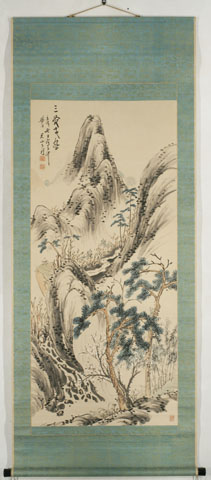Nanga
Landscape with the three friends of winterSigned: sha u Chikuôtei Kunzan rôshô
Seals: Fujimoto Makane, Kibi danshi, Tesseki (bottom)
Technique: colours on paper 136,7 x 61,5
Date: Winter of 1862
Mounting: azure damask 192 x 77,8
Box: inscribed
Condition: very good
Inscription reads: Sanyû sai mitsu, Three talented friends together
The importance of Tesseki as a painter has been overshadowed by his political career and his romantic death as a martyr.
Tesseki was born into a samurai family from Okayama. From childhood he studied literature, poetry and calligraphy, Chinese as well as Japanese and the Chinese Sung style of painting, but also military tactics and martial arts. At the age of 25, or 26 he went to Osaka and later to Kyoto. His military education, which he received from Hanabusa Iwao in Kyoto, resulted in the rank of master swordsman. Tesseki was requested to start an art school at Fushimi. He taught many pupils, but in 1843, like many young intellectuals at that time he went on a journey and studied at the Kangien.
After paying his respect to the mausoleum of the Jimmu emperor from Nara, he traveled many parts of Japan and returned to Kyoto in 1851. Since Ii Naosuke (1815-60), the Chief Minister of the Tokugawa Shogunate signed the treaty with the foreigners, and after the imperial princess Kazu (1846-77) married Tokugawa Iemochi (1846-66) in a political alliance in 1862, Tesseki became a violent imperialist. Tesseki joined several raids and was killed at Nara in a fight against the soldiers of the Kishu Clan.
Reference:
Berry & Morioka ’08 p. 254-56 (# 65, 76)
Roberts p. 177
Araki p. 2749
Nagasawa # 3858
Kato ’98 (chapter 1) # 128-137
Addiss '83 pp. 198-199
Hong Kong 1974 p. 120
Price: SOLD

